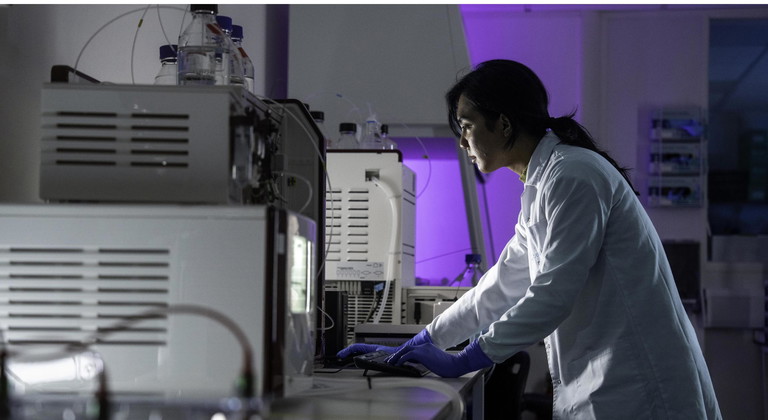SPOT LIGHT
Synthetic DNA: breaking the bottleneck in genetic medicine manufacturing
Why is the use of synthetic DNA a better choice for emerging genetic medicines?
Amy Walker at 4basebio
Genetic medicines have surged to the forefront of therapeutic innovation, with applications spanning mRNA and DNA vaccines, cell and gene therapies (CGTs), and gene-editing technologies. These breakthroughs are reshaping the healthcare landscape, with mRNA vaccines demonstrating unprecedented speed and effectiveness in combatting infectious diseases. Meanwhile, mRNA and DNA cancer immunotherapies are entering clinical trials with incredible promise. CGTs are delivering transformative outcomes for cancer patients and those with rare genetic disorders and previously untreatable diseases, and gene-editing technologies are unlocking new possibilities for precision medicine. While these advances are revolutionising modern medicine, they are also fuelling an urgent drive for innovation in how these genetic medicines are made.
As a critical starting material for these modalities, the biopharma industry has historically relied on plasmid DNA (pDNA). pDNA provides the starting template for in vitro transcription (IVT) of mRNA therapeutics and vaccines, the inputs for viral vector production and supports gene-editing technology as a donor template. As the field has rapidly expanded, so too has the strain on the pDNA supply chain.
pDNA is manufactured through bacterial fermentation. Briefly, the desired genetic sequence is cloned into a bacterial plasmid, which is then transformed into E. coli cells. As the bacteria proliferate, they replicate the plasmid, producing large quantities of DNA.
After fermentation, the pDNA is subject to a series of downstream processing steps to harvest, lyse and purify the DNA, removing harmful contaminants like endotoxins and host cell proteins. In the case of mRNA production, purified pDNA is further processed by enzymatic linearisation before use in an IVT reaction, where RNA polymerase generates the corresponding mRNA strand.

Producing good manufacturing practice (GMP)-grade pDNA suitable for clinical development is a lengthy, costly and complex process, one that can take anywhere from nine to 12 months. For companies navigating aggressive development timelines or responding to urgent public health needs, such as in a pandemic, these delays are particularly problematic. For example, in personalised cancer immunotherapies, reducing the time from manufacture to treatment is paramount to clinical success.
Beyond the lengthy timelines, pDNA comes with several other pain points. pDNA production relies on bacterial fermentation processes that introduce unwanted elements like bacterial DNA backbones and antibiotic-resistance genes – both of which are present in the final pDNA product. The use of antibiotics in bacterial fermentation also poses a regulatory concern in sensitised patients receiving a plasmid-derived drug substance. Process-related impurities, like host cell proteins and endotoxins, must be meticulously removed to meet safety standards established by regulatory agencies. Furthermore, large-scale production involves significant investment in infrastructure and yields a modest output. To complicate matters further, a global shortage of large-scale GMP pDNA manufacturing capacity means even well-resourced organisations face lengthy wait times to get sufficient starting material for their applications.
Taken together, these factors have led many in the industry to view pDNA as an essential, yet increasingly limiting, material that threatens to slow the pace of innovation in genetic medicines.
The future is synthetic
In an era defined by speed, scalability and safety, synthetic DNA has emerged as a next-generation alternative to pDNA. It offers many advantages and the potential to ease long-standing manufacturing bottlenecks in the production of mRNA and DNA vaccines, viral vectors for CGTs, and for gene-editing applications. Produced via cell-free, enzymatic methods, synthetic DNA sidesteps many of the limitations inherent to pDNA. One of its most immediate advantages is speed: synthetic DNA can move from sequence to GMP production in as little as eight weeks – a dramatic improvement over the months-long timelines traditionally associated with pDNA.
Beyond speed, synthetic DNA offers several critical advantages. It eliminates the risk of bacterial contaminants, including endotoxins and antibiotic-resistance genes, by using an entirely cell-free process. 4basebio’s linear and 3' open-ended DNA templates simplify IVT workflows by eliminating the need for enzymatic linearisation of the pDNA and subsequent purification step, which improves process consistency and efficiency. Synthetic methods also support the production of longer, more stable poly(A) tails, which enhance mRNA translational efficiency and stability: eliminating the bacterial fermentation mitigates the risk of homologous recombination events commonly associated with polyA sequences, enhancing polyA homogeneity and decreasing the likelihood of batch failure. From an operational perspective, synthetic DNA offers a compact production footprint with higher yields and simpler downstream purification. This translates into fewer failure points, greater batch-to-batch consistency and more reliable manufacturing; important benefits to key functions within biopharma organisations, from process development and chemistry, manufacturing, and controls (CMC), to quality control and regulatory affairs.
Given the advantages of synthetic DNA over pDNA and evidence of clinical development, adoption is gaining momentum in the biopharmaceutical industry.
HelixNano chooses synthetic DNA
HelixNano, a 4basebio customer, is developing next-generation mRNA technologies to expand the reach of mRNA vaccines and therapies, particularly for patients where traditional approaches have been less effective, such as those who are immunocompromised or immunosuppressed. From the outset, HelixNano opted to use synthetic DNA instead of pDNA for the manufacture of its mRNA drug products. As a small company without legacy processes, it evaluated its options from first principles. In addition to the speed enabled by synthetic DNA as it advanced towards the clinic, two other key factors drove its decision.
The first was the time and cost associated with developing a poly(A)-stable cell bank for plasmid production.
HelixNano wanted the mRNA’s poly(A) tail to be encoded directly in the plasmid, as enzymatic addition after RNA production introduces added complexity, variability, time and cost. However, engineering a stable bacterial strain to reliably maintain a long poly(A) tail is technically challenging, often delaying development and increasing upfront costs – an unacceptable burden for a small, resource-conscious company.
The second factor was the expected impurity profile of the DNA itself, as well as the impact on downstream mRNA impurities. Synthetic DNA, produced enzymatically without cells, offers a starting material with a narrower impurities profile compared to cell-derived DNA. Also, with pDNA – even after linearisation – residual circular DNA can remain, leading to high molecular-weight side products during IVT. These impurities can necessitate additional purification steps and can compromise mRNA quality.
In contrast to pDNA and other synthetic DNA offerings, 4basebio’s opDNA construct has been uniquely designed to be both linear and open on the 3' end, eliminating the risk of circular contaminants and removing the enzymatic linearisation or de-ending step from the IVT workflow.
“ With the right partner and a clear strategy, companies can unlock synthetic DNA’s benefits, de-risking manufacturing, reducing lead times and accelerating development milestones, while maintaining programme continuity and momentum ”
Among synthetic DNA providers, 4basebio stood out to HelixNano for two reasons: its advanced GMP readiness and end-processing efficiency. 4basebio’s manufacturing processes reduced the risk of secondary structures and T7 rollback artefacts, which can negatively impact mRNA quality. Its GMP readiness also offered HelixNano a faster, more straightforward regulatory path through clinical trials, reducing development risk – an essential advantage in the fast-moving field of advanced therapies.
HelixNano is using synthetic DNA manufactured by 4basebio in a novel mRNA vaccine platform designed to overcome the limitations of inducing protective vaccine responses in immunosuppressed patients. The company’s initial clinical programme is currently ongoing in Australia. As an early adopter, the company sees synthetic DNA as the future of genetic medicine manufacturing and expects broader industry adoption once the first biologics licence application approval using synthetic DNA templates is secured.
Evolving from pDNA to synthetic DNA
While HelixNano adopted synthetic DNA from the outset, companies currently using pDNA can also make a smooth transition to synthetic DNA templates with the right planning and support.
The process begins with a practical assessment of how existing production platforms can accommodate synthetic DNA formats, including any necessary adjustments to analytical methods or release-testing protocols. Typically, there is very little optimisation required, and clients can simply reduce the dose of DNA required whilst following standard operating procedures. The timing of the switch is also an important consideration; some developers choose to incorporate synthetic DNA into ongoing programmes, while others take advantage of natural inflection points – such as the start of a new development phase – to streamline the transition. Fortunately, experienced synthetic DNA partners like 4basebio can help guide this process. With deep expertise in synthetic DNA manufacturing and regulatory expectations, we can partner with development teams to design efficient comparability studies, optimise workflows and ensure seamless integration.
Many organisations have already demonstrated that midstream transitions are not only achievable but can also offer significant advantages. With the right partner and a clear strategy, companies can unlock synthetic DNA’s benefits, de-risking manufacturing, reducing lead times and accelerating development milestones, while maintaining programme continuity and momentum.
Regulatory outlook
Synthetic DNA intended for use in clinical trials is manufactured under stringently controlled conditions, adhering to GMP standards. Like GMP-grade pDNA, its production involves comprehensive documentation practices, providing full traceability of all materials, processes and manufacturing equipment. To facilitate regulatory acceptance, early engagement is key. Companies should work collaboratively with regulatory agencies to define expectations, design robust comparability studies, and ensure transparency and traceability throughout the synthetic DNA production and quality control processes. As synthetic DNA is incorporated into more early-phase clinical programmes, regulatory familiarity and comfort with the platform continue to grow.
Looking ahead: catalysing a new standard
The shift to synthetic DNA represents a pivotal moment for the genetic medicine manufacturing landscape. As the technology gains additional traction and validation through clinical and regulatory successes, its advantages of faster timelines, dose sparing, improved safety profiles and more scalable production become increasingly compelling. In an industry under intense pressure to innovate faster and more efficiently, the ability to eliminate one of the most persistent manufacturing bottlenecks is not just advantageous, it can be essential for future competitiveness. To fully unlock the potential of synthetic DNA, the biopharma industry should consider this alternative to pDNA. By doing so, we can build a more agile, resilient and forward-looking approach to genetic medicine development; one better equipped to deliver the next generation of transformative therapies to patients around the world.

Amy Walker brings over ten years of scientific and commercial expertise in life sciences, and currently serves as the chief operating officer of 4basebio. Walker oversees the company’s synthetic DNA and targeted nonviral delivery platforms, driving their commercial development. 4basebio provides innovative technologies and products for gene therapy and vaccine development. Our enzymatic DNA synthesis platform allows for the GMP production of DNA products at unparalleled speed, scale and purity as compared to pDNA. The proprietary DNA products feed into the production of mRNA, viral vectors and DNA vaccine technologies. 4basebio’s targeted, nonviral delivery platform, Hermes, allows targeting towards specific cells or tissues of interest, and is suitable for a range of nucleic acid and biological payloads. Together, these platform technologies can greatly accelerate the development of gene therapy and vaccine programmes. Visit: www.4basebio.com